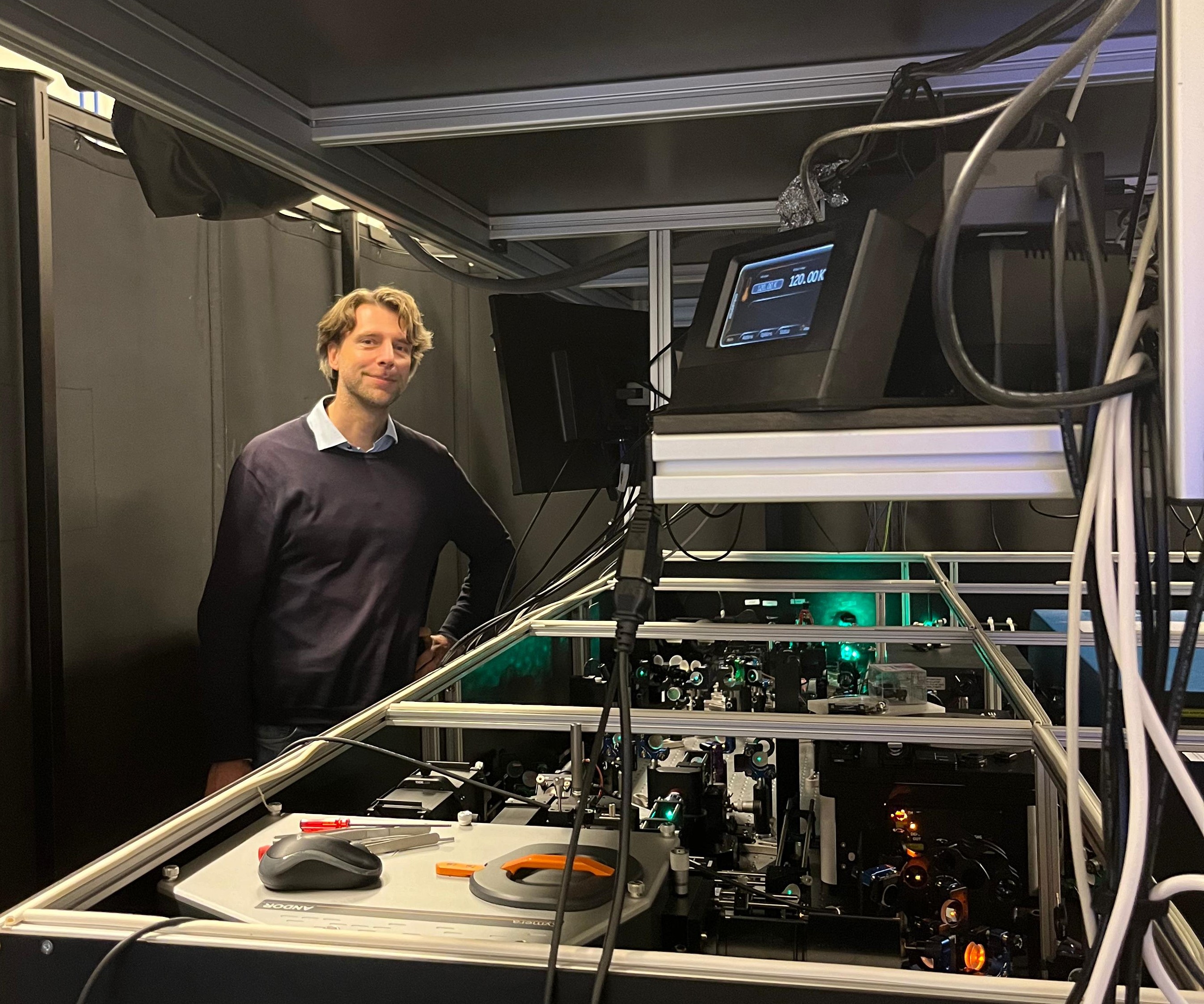Research highlight
Harnessing ultrafast heat
Probing and understanding ultrafast dynamics in nanoscale systems, with the ultimate aim to exploit them. That is the golden thread in the research of Associate Professor Klaas-Jan Tielrooij. His group is at the forefront of the emerging topic of understanding and controlling heat in layered materials.
At Eindhoven Hendrik Casimir Institute, Tielrooij’s group called ‘Ultrafast Dynamics in Nanoscale Systems’ is associated with the Advanced Nanomaterials & Devices capacity group. In addition, part of his group is still located at the Catalan Institute of Nanoscience and Nanotechnology in Spain, where he started back in 2018.
Using self-built experimental microscopy techniques with femtosecond temporal and nanometer spatial accuracy, the group is working on the fundamental understanding of transport and dynamics of different degrees of freedom in 2D and 1D systems. This includes charge, vibration, and heat. They use this understanding to develop concepts for thermal management, photodetection, and terahertz technologies.

Three lines
‘The research in my group revolves around three interwoven lines,’ Tielrooij explains. ‘We are looking at optical-photonic, optothermal, and optoelectronic properties, at extremely small time and length scales. In part of this research, we focus on layered
materials like graphene and transition metal dichalcogenides, where there are no chemical bonds between the individual layers of the material.’
Tielrooij recently acquired an ERC Consolidator Grant for a high-risk/high-gain project that explores the possibilities of using ultrafast thermodynamic properties of nanomaterials to generate and detect terahertz radiation. This work builds on previous results from his ERC Starting Grant project on controlling ultrafast heat in layered materials.
Making heat transport visible
‘That research started from an interest in graphene and related materials and their many intriguing properties. The way heat behaves in these layered materials was not yet understood, so we decided to dive into that topic.’ The group developed novel techniques to study heat dissipation in detail. ‘We use ultrafast light pulses to make snapshots of how the heat spreads over time. First, we fire a pulse to locally heat a sample, made out of a thin membrane suspended over a hole in a substrate. Then, we use a second laser pulse to probe how the heat is transported through the membrane. Since we can probe at timescales in the order of 100 femtoseconds, we can make ultrafast “videos” and disentangle the behavior of the charge carriers from that of the lattice vibrations (phonons), unraveling both charge and heat transport mechanisms.’
The group used similar techniques to study the interactions between electrons and phonons in a graphene sandwich, in which one layer of graphene is placed on another graphene layer, but under a small angle, around 1°. This so-called magic-angle twisted bilayer graphene has some astounding properties, including superconductivity, for which no full explanation exists. In a recent paper in the journal Science Advances, Tielrooij and his collaborators reported that the energy of the electrons in such a sandwich is transferred to the phonons much faster than in a non-twisted stack of two graphene sheets. With their experiments, the researchers uncovered a completely new physical process where electrons interact with phonons in a similar way to how phonons interact with other phonons in non-metallic materials at room temperature – via so-called Umklapp scattering.

“That research started from an interest in graphene and related materials and their many intriguing properties. The way heat behaves in these layered materials was not yet understood, so we decided to dive into that topic.”
Klaas-Jan Tielrooij | Associate Professor

Being first
This paper is a good example of the research Tielrooij wants to do, he says. ‘I love to be the first to observe something. But I also like to be the first to make use of the new processes we discover. That is one of the reasons I decided to move a large part of my research group to TU/e: the threshold to collaborating with industry is very low here, and the companies in this region are genuinely interested in the topics I am working on.’
What’s more, the ambitious physicist sees ample opportunities for collaboration within the Eindhoven Hendrik Casimir Institute itself. ‘In the AND group alone there are many interesting complementarities with the work of other principal investigators. For example, my first collaborative project here was a bachelor end-project, where we looked into using layered materials to cool nanowires. That was very successful: the associated bachelor student Wiktor Kwapinski received both the SPIN and the TU/e prize for his thesis. I also have ongoing projects/proposals with the PSN, PMP, MBx, Phi, and ECO groups at the Applied Physics and Science Education and Electrical Engineering departments.’
Novel regimes of physics
In his ERC Consolidator project, Tielrooij is now combining his expertise on optics, optoelectronics, and optothermal phenomena: ‘Terahertz radiation is a challenging regime. It is too high frequency for electronics, and too low for optics. My aim is to use the ultrafast thermodynamic properties of quantum materials to unlock novel regimes of physics, that do not exist in standard materials, and use these to generate and detect terahertz radiation with unprecedented performance.’